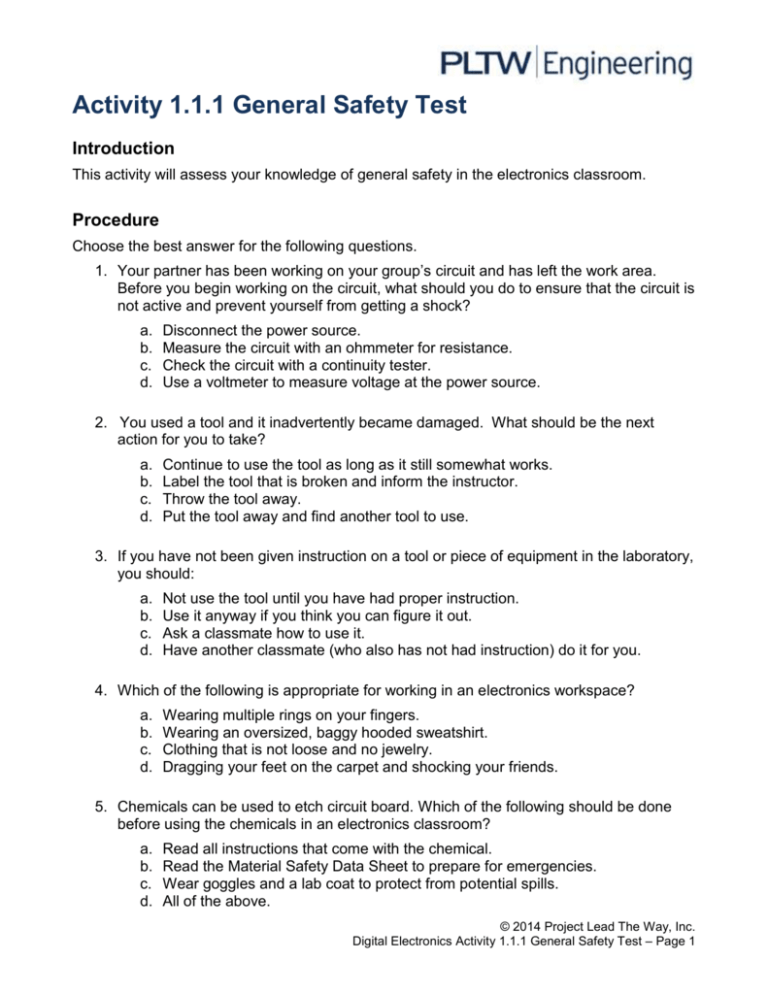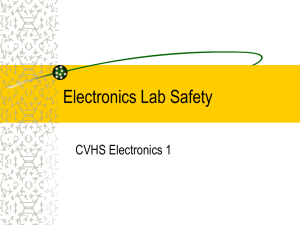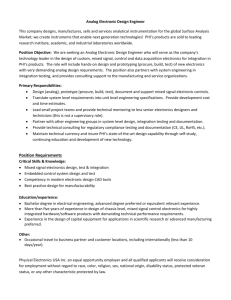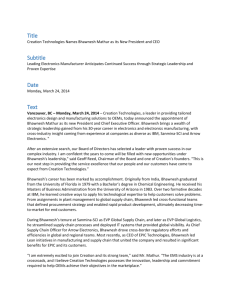1.1.1.A General Safety Test
advertisement

Activity 1.1.1 General Safety Test Introduction This activity will assess your knowledge of general safety in the electronics classroom. Procedure Choose the best answer for the following questions. 1. Your partner has been working on your group’s circuit and has left the work area. Before you begin working on the circuit, what should you do to ensure that the circuit is not active and prevent yourself from getting a shock? a. b. c. d. Disconnect the power source. Measure the circuit with an ohmmeter for resistance. Check the circuit with a continuity tester. Use a voltmeter to measure voltage at the power source. 2. You used a tool and it inadvertently became damaged. What should be the next action for you to take? a. b. c. d. Continue to use the tool as long as it still somewhat works. Label the tool that is broken and inform the instructor. Throw the tool away. Put the tool away and find another tool to use. 3. If you have not been given instruction on a tool or piece of equipment in the laboratory, you should: a. b. c. d. Not use the tool until you have had proper instruction. Use it anyway if you think you can figure it out. Ask a classmate how to use it. Have another classmate (who also has not had instruction) do it for you. 4. Which of the following is appropriate for working in an electronics workspace? a. b. c. d. Wearing multiple rings on your fingers. Wearing an oversized, baggy hooded sweatshirt. Clothing that is not loose and no jewelry. Dragging your feet on the carpet and shocking your friends. 5. Chemicals can be used to etch circuit board. Which of the following should be done before using the chemicals in an electronics classroom? a. b. c. d. Read all instructions that come with the chemical. Read the Material Safety Data Sheet to prepare for emergencies. Wear goggles and a lab coat to protect from potential spills. All of the above. © 2014 Project Lead The Way, Inc. Digital Electronics Activity 1.1.1 General Safety Test – Page 1 6. What is the maximum current level that a human body can withstand before sustaining injury? a. b. c. d. 100 uA 1.0 mA 15 mA 50 mA 7. A large voltage is applied to a circuit and a fire is started on a circuit board in the lab. When you inform your instructor, which of the following should the instructor use to extinguish an electrical fire? a. b. c. d. Water. Class A fire extinguisher. Class B fire extinguisher. Class C fire extinguisher. 8. Before working with a chemical or solder, a student obtained a Material Safety Data Sheet. Which of the following will the student find on this document? a. b. c. d. What the chemical is made of. The first aid procedure that you should follow. How to handle the material. All of the above. 9. Which of the following is the appropriate scenario for wearing safety glasses in an electronics classroom? a. Safety glasses or goggles should be worn to prevent eye injuries from chemicals that splash. b. Safety glasses or goggles should be worn when using tools that may cause objects to be thrown. c. Safety glasses or goggles should be used when soldering components. d. All of the above. 10. Why should the students not rush? Why should students take their time when working in an electronics classroom? a. Taking your time allows you to double check your connections and to reduce the need for troubleshooting later. b. Taking your time allows you to create your circuits more neatly. This allows you to pick up where you left of last time more easily. c. Taking your time allows you to double check all part numbers and values. A common error. d. All of the above. 11. What are the types of injury that are most common in an electronics classroom? a. b. c. d. Electrical shock. Sprained finger. Answers (a) and (d). Minor burns from active electrical components. © 2014 Project Lead The Way, Inc. Digital Electronics Activity 1.1.1 General Safety Test – Page 2 12. The electrical cord for a soldering iron has a grounding prong. However the extension cord you are trying to plug into only has only a place for 2 prongs (no grounding prong). What should you do in order to plug in the tool? a. b. c. d. Wire the grounding prong to the neutral prong on the soldering iron. Use an appropriate adapter/extension cord. Cut off the grounding pin. All of the above. 13. When you enter the electronics classroom, you notice there is water on the floor near an electrical outlet. The roof appears to be leaking. Which of the following should be done first? a. Immediately mop the floor. b. Make sure no one enters and turn the power off to the classroom at the circuit breaker. c. Disregard the problem as long as it is not near projects workspace. d. Mop the floor with an insulated mop. 14. You notice that the cord of your soldering iron is frayed and possibly broken. What should be done next? a. b. c. d. If the cord works, continue to use the soldering iron. Label the broken section and notify the instructor. Put the soldering iron back and pick one without a frayed cord. Throw the soldering iron away. 15. A student obtained an injury in the electrical classroom. The accident should be brought to the attention of the instructor so that: a. b. c. d. The teacher can document the injury. The teacher can administer first aid. The teacher can make sure other students are not injured. All of the above. 16. It is important to keep your workspace clean and organized in an electronics classroom. Which of the following is not a reason for doing so? a. This allows other classmates to easily locate materials when sharing the same workspace. b. Minimizes the potential for injuries. c. These practices help maintain the equipment in the electronics classroom. d. It gives students something to do. 17. Chemicals, materials, and processes in an electrical lab can be dangerous. Which of the following is not a potential hazard in typical electronics classrooms? a. b. c. d. Burns from hot/active components or from a soldering iron. Electrocution. Fumes from soldering. Falling objects. © 2014 Project Lead The Way, Inc. Digital Electronics Activity 1.1.1 General Safety Test – Page 3 18. Certain devices in an electronics classroom such as capacitors can store a lethal amount of charge. When handling a capacitor you will want to ensure that the device is uncharged. How do you make certain a capacitor is discharged before handling? a. b. c. d. Use an ammeter to read current. Touch the leads with your finger. Ask your instructor. Use an ohmmeter to read resistance. 19. You are getting ready to power another student’s electrical circuit in this class, but you are not sure of the voltage necessary to use. Students in this class should always use: a. b. c. d. 5V because all the components we use are always TTL. 3.3V because all the component we use are always CMOS. 9V because that is the battery lying next to the circuit. Check with the other student who created it or the instructor. The design may require different voltages based on what it does, and how it’s designed. 20. It is a good practice in an electronics classroom to: a. Always follow procedure. b. Investigate before you act. Read and review all datasheets and service manuals. c. When in doubt, ask your instructor d. All of the above. © 2014 Project Lead The Way, Inc. Digital Electronics Activity 1.1.1 General Safety Test – Page 4






